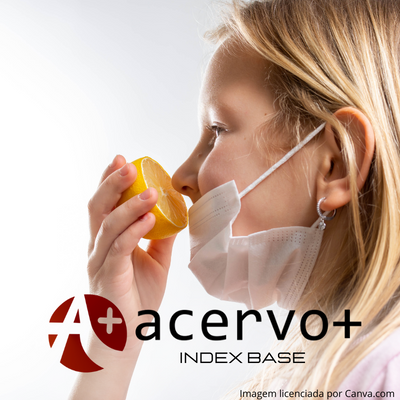Perfil clínico dos pacientes com anosmia persistente infectados pelo SARS-CoV-2 no estado do Amazonas, Brasil
##plugins.themes.bootstrap3.article.main##
Resumo
Objetivo: Compreender o perfil clínico dos pacientes com perda olfatória devido a infecção pelo SARS-CoV-2, além de sua persistência ao longo do período do estudo e a presença de possíveis fatores associados. Métodos: Inicialmente, foi colhido questionário via formulário online a fim de avaliar as queixas do paciente, e em seguida foram realizadas avaliações presenciais para realização de testes olfatórios a fim de mensurar a anosmia. Resultados: 75 pacientes foram incluídos no estudo, 56 (75%) do sexo feminino e 19 (25%) do sexo masculino. Em relação ao estudo do sentido do olfato realizado de forma presencial, foi observado que, à medida que mais avaliações eram realizadas, melhor se tornava a percepção deste sentido pelo paciente. Entretanto, nem todos os 75 pacientes contidos na amostra conseguiram realizar todas as avaliações sugeridas. Conclusão: A investigação para um melhor manejo dos distúrbios olfatórios deve ser contínua, pois muitas questões seguem incertas, principalmente as relacionadas à fisiopatologia, à avaliação objetiva da anosmia e ao seu tratamento.
##plugins.themes.bootstrap3.article.details##
Copyright © | Todos os direitos reservados.
A revista detém os direitos autorais exclusivos de publicação deste artigo nos termos da lei 9610/98.
Reprodução parcial
É livre o uso de partes do texto, figuras e questionário do artigo, sendo obrigatória a citação dos autores e revista.
Reprodução total
É expressamente proibida, devendo ser autorizada pela revista.
Referências
2. BOESVELDT S. Anosmia – A Clinical Review. Chemical Senses – Oxford Academic, 2017; 42(7): 513-523.
3. BRANDÃO NETO D, et al. Chemosensory Dysfunction in COVID-19: Prevalences, Recovery Rates, and Clinical Associations on a Large Brazilian Sample. Otolaryngology – Head and Neck Surgery, 2021; 164(3): 512-518.
4. BRIDWELL R, et al. Neurologic complications of COVID-19. American Journal of Emergency Medicine, 2020; 38(7): 1549.e3-1549.e7.
5. CHEW SY, et al. Characteristics and Outcomes of COVID-19 Patients with Respiratory Failure Admitted to a "Pandemic Ready" Intensive Care Unit - Lessons from Singapore. Annals of the Academy of Medicine of Singapore, 2020; 47(7): 434-448.
6. DA SILVA JÚNIOR PR, et al. Anosmia and COVID-19: perspectives on its association and the pathophysiological mechanisms involved. The Egyptian Journal of Neurology, Psychiatry and Neurosurgery, 2021; 57(1): 8.
7. ELLUL MA, et al. Neurological associations of COVID-19. The Lancet Neurology, 2020; 19(9): 767-783.
8. ATTEMS J, et al. Olfaction and Aging: A Mini-Review. Gerontology, 2015; 61: 485-490.
9. BEZERRA TFP, et al. Quality of life assessment septoplasty in patients with nasal obstruction. Brazilian Journal of Otorhinolaryngology, 2012; 78(3): 57-62.
10. OBESITY AND OVERWEIGHT. 2021. In: World Health Organization. Geneva, Switzerland. Disponível em: https://www.who.int/en/news-room/fact-sheets/detail/obesity-and-overweight. Acesso em: 2 jan. 2023.
11. ISENMANN S, et al. Stórungen der Chemosensorik bei COVID-19: Pathomechanismen und klinische Relevanz. Fortschritte der Neurologie – Psychiatrie, 2021; 89(6): 281-288.
12. KOBAYASHI M, et al. A new clinical olfactory function test: cross-cultural influence. Archives of Otolaryngology – Head & Neck Surgery, 2007; 133(4): 331-336.
13. KOYAMA S, et al. Possible Use of Phytochemicals for Recovery from COVID-19-Induced Anosmia and Ageusia. International Journal of Molecular Sciences, 2021; 22(16): 1-71.
14. LAS CASAS LIMA MH, et al. Pathophysiological relationship between COVID-19 and olfactory dysfunction: A systematic review. Brazilian Journal of Otorhinolaryngology, 2021; 1078: 1-10.
15. LECHIEN JR, et al. Olfactory and gustatory dysfunctions as a clinical presentation of mild-to-moderate forms of the coronavirus disease (COVID-19): a multicenter European study. European Archives of Oto-Rhino-Laryngology, 2020; 277(8): 2251-2261.
16. MLHAVE, M.; AGERGAARD, J.; WEJSE, C. Clinical Management of COVID-19 Patients – An Update. Seminars in Nuclear Medicine, 2022; 52(1): 4-10.
17. MASTRANGELO A, et al. Smell and taste disorders in COVID-19: From pathogenesis to clinical features and outcomes. Neuroscience Letters, 2021; 748: 1-6.
18. MEHRAEEN E, et al. Olfactory and gustatory dysfunctions due to the coronavirus disease (COVID-19): a review of current evidence. European Archives of Oto-Rhino-Laryngology, 2020; 278(2): 307-312.
19. NAJAFLOO R, et al. Mechanism of Anosmia Caused by Symptoms of COVID-19 and Emerging Treatments. ACS Chemical Neuroscience, 2021; 12(20): 3795-3805.
20. TRECCA, E. M. C., et al. Results from psychophysical tests of smell and taste during the course of SARS-CoV-2 infection: a review. Acta Otorhinolaryngologica Italica, 2022; 42(1): 20-35.
21. VERONESE S e SBARBATI A. Chemosensory Systems in COVID-19: Evolution of Scientific Research. ACS Chemical Neuroscience, 2021; 12(5): 813-824.
22. VILLWOCK JA, et al. Affordable Rapid Olfaction Measurement Array: A Novel, essential oil-based test strongly correlated with UPSIT and subjective outcome measures. Annals of Otology, Rhinology & Laryngology, 2020; 129(1): 39-45.
23. ZAZHYTSKA M, et al. Non-cell-autonomous disruption of nuclear architecture as a potential cause of COVID-19-induced anosmia. Cell, 2022; 185(6): 1052-1064.

